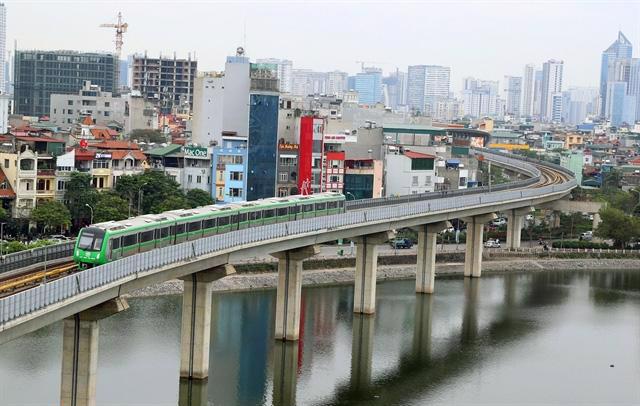The sluggish construction of urban metro lines in Vietnam, which have been touted as a means of easing traffic congestion in major cities, along with stalled national railway upgrades, has created ripple effects that hinder the country’s growth and infrastructure development. As urban railway projects struggle with delays and mounting challenges, experts point to limitations in the traditional project management (PM) consulting model. In its place, the project delivery partner (PDP) model is emerging as a more effective solution, especially for large-scale and complex railway developments.
Slow projects
In major cities like Hanoi and Ho Chi Minh City, urban railway projects are seen as a key solution to addressing traffic congestion. However, progress has been significantly slower than planned, with project timelines continuously being pushed back.
The Nhon - Hanoi Railway Station Metro Line, despite multiple adjustments, is still under construction, with underground sections yet to be completed. The latest target for full operation is now 2027; nearly a decade behind its original schedule. Similarly, the Nam Thang Long - Tran Hung Dao Metro Line (Line 2) remains on the drawing board 17 years after the city approved its feasibility study in November 2008, with no breaking of ground in sight. In Ho Chi Minh City, the Ben Thanh - Suoi Tien Metro Line has finally begun operations, but only after numerous delays and adjustments saw it repeatedly miss deadlines.
Beyond urban metro systems, national railway projects, including both upgrades and new projects, are also stagnating. Existing railway lines, even with renovations, still fail to meet the rising demand for transport. Outdated infrastructure, slow travel speeds, and limited capacity have weakened the railway sector’s competitiveness, making it increasingly less attractive compared to other transportation options.
The North-South high-speed railway line, a strategic project already approved by the National Assembly, remains stuck in the research and preparation phase. Given the slow progress of past railway projects, experts are skeptical about whether construction can begin by 2027, as planned.
Vietnam’s persistent delays in railway projects stem from a range of complex challenges. These include difficulties in site clearance, the limited capabilities of some contractors, a lack of coordination in planning and execution, cumbersome legal procedures, and financial constraints. Inefficient project management further exacerbates the situation, leading to extended timelines and cost overruns.
To break this cycle, a more decisive and coordinated approach from the entire political system is needed. According to Mr. Nguyen Trong Nghia, CEO of the Invest Global IC JSC, improving PM is key. “The traditional PM consulting model has exhibited limitations,” he emphasized. “The PDP model is seen as a more effective solution, particularly for large-scale and complex railway projects.”
Comprehensive and flexible solution
The fundamental difference between the two models, he continued, lies in their approach and scope of responsibility. While the PM model primarily focuses on planning, organizing, coordinating, and monitoring progress, the PDP model is more comprehensive, engaging deeply in strategic consulting, technical design, and risk management.
In the implementation of urban railway projects, the PM model often encounters issues such as delays, shortages of highly-specialized personnel, and a lack of experience in EPC (Engineering, Procurement, and Construction) contracts. While the PM approach is suitable for projects with stable processes, it proves less effective when dealing with the complexities and unpredictable changes inherent in railway infrastructure projects.
Conversely, the PDP model fosters close collaboration between stakeholders from the planning phase through to project completion. Rather than simply overseeing progress, PDP actively participates in design, engineering, and risk management, ensuring the project’s overall efficiency. Its flexibility is evident in its ability to adopt various contract management approaches and optimize cost structures, unlike the rigid adherence to traditional PM models.
“One of the PDP model’s greatest advantages is its high level of integration and collaboration,” Mr. Nghia said. “This model facilitates close coordination between the government, construction contractors, consultants, and experts, optimizing project design, management, and execution, thereby reducing completion times. Establishing partnerships also enables swift resolution of emerging issues, enhances transparency and accountability, and strengthens communication and consensus between stakeholders.”
Moreover, PDP ensures project quality and timely execution through a multidisciplinary team of seasoned experts who can devise optimal solutions and respond swiftly to risks. This model also employs comprehensive risk management strategies, helping to anticipate and control unforeseen factors, ensuring the project stays on schedule and within budget.
Another strength of PDP is its adaptability to change. It can integrate advanced construction technologies such as Building Information Modeling (BIM) to optimize design and execution while assisting investors in selecting suitable suppliers and contractors and ensuring compliance with legal regulations.
Ultimately, PDP plays a crucial role in streamlining the development process of railway projects, seamlessly connecting all phases, from design and construction to operation, to ensure service continuity.
Three-tier governance model
Based on the aforementioned advantages and to effectively implement railway projects, Mr. Nghia proposed a three-tier governance model, comprising the Project Steering Committee, the PDP, and the main contractors.
The Project Steering Committee, under the government’s direct authority and chaired by a Deputy Prime Minister, would be responsible for overall project management, capital allocation, investment mobilization, and the selection of the PDP.
The Committee’s members would include both individuals and organizations, such as the Railway Project Management Board, specialized research institutes, real estate developers involved in Transit-Oriented Development (TOD) urban areas, and railway operation entities.
During implementation, the Project Steering Committee would coordinate domestic funding over medium-term periods, attract investment from international financial institutions, such as the World Bank (WB), the Asian Development Bank (ADB), and the Asian Infrastructure Investment Bank (AIIB), and auction land in TOD station areas to generate financial resources for the project.
The PDP entity, to be established as an independent legal entity through a joint venture of domestic (40 per cent) and international (60 per cent) consultancy firms, would be responsible for master planning, risk management, design verification, and construction supervision.
The main contractors, including EPC general contractors and domestic technology enterprises such as Viettel and VNPT (handling critical components like information and control systems), would be responsible for designing, constructing, and installing systems under a public-private partnership (PPP) model.
This governance model is expected to enhance transparency and efficiency in project management, ensuring the optimal mobilization of financial, human, and technological resources, thereby contributing to the success of railway projects in Vietnam and driving the development of modern transport infrastructure, Mr. Nghia emphasized.









 Google translate
Google translate